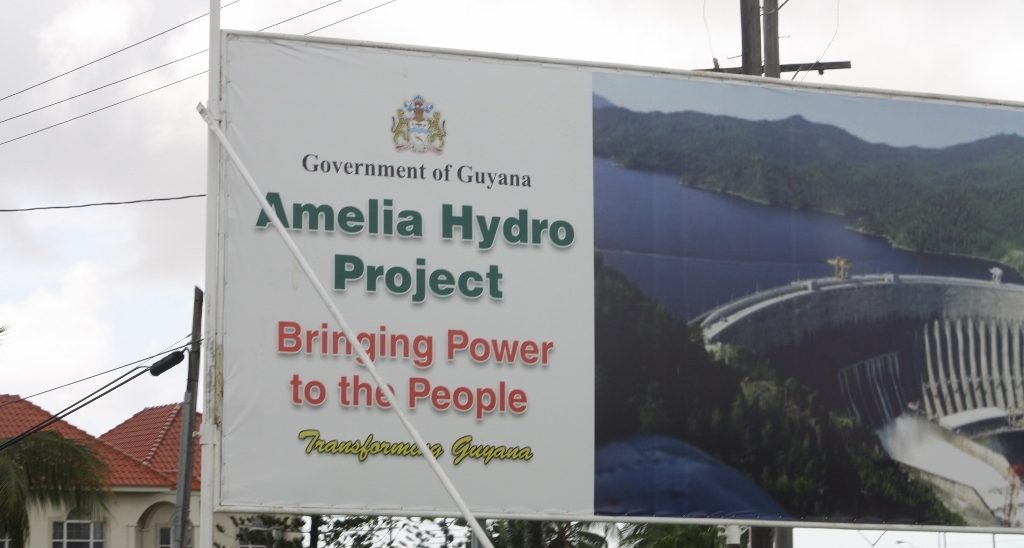 Hydropower has the ability to transform a country’s electricity spectrum with cleaner energy thus contributing to the reduction of global warming as well as saving the environment. Guyana, a country with vast rainforests and hundreds of waterfalls, took up the mantle and included the Amaila Falls Hydroelectricity Project (AFHP) as part of the Low Carbon Development Strategy (LCDS) under the stewardship of then President Bharrat Jagdeo.
Hydropower has the ability to transform a country’s electricity spectrum with cleaner energy thus contributing to the reduction of global warming as well as saving the environment. Guyana, a country with vast rainforests and hundreds of waterfalls, took up the mantle and included the Amaila Falls Hydroelectricity Project (AFHP) as part of the Low Carbon Development Strategy (LCDS) under the stewardship of then President Bharrat Jagdeo.
Touted as the keystone of the LCDS, the AFHP was launched in 2009 but has been on hold since 2013 when the developer Sithe Global pulled out. The reason for Sithe Global’s withdrawal was due to the lack of consensus in Parliament.
The then Opposition A Partnership for National Unity (APNU) and Alliance For Change (AFC) both expressed concerns about the project and voted down a key piece of legislation which consequently shelved the project.
Despite the uncertainty about the project, in 2014, Norway transferred US$80 million to the Inter-American Development Bank as part of the Norwegian International Climate and Forest Initiative’s US$250 million REDD deal with Guyana. The money is intended as part-funding of the dam, the cost of which has grown over the years from US$325 million to almost US$1 billion.
Under the Norwegian Government’s budget regulations, grants must be used within one year. An exception was made for the Amaila Falls Project, allowing the money to remain with the IDB for 18 months.
By mid-2016, Guyana had a new government, which opposed the construction of the Amaila Falls dam. The Norwegian Agency for Development Cooperation (NORAD), in 2016, commissioned a review of the Amaila Falls dam which was carried out by Norconsult.
“The only realistic path for Guyana towards an emission-free electricity sector is by developing its hydropower potential. The fastest way forward is to maintain AFHP [Amaila Falls Hydropower Project] as the first major step for substituting its current oil-fired generation,” Norconsult concluded in its report.
The AFHP was prioritised as the first hydropower plant because it was the only project with a full feasibility study completed, it has a higher plant load factor than the alternatives, a smaller reservoir and a revised unit cost in the same range as the most attractive alternatives.
The report also indicated that Amaila Falls alone cannot provide 100 per cent emission-free power generation in Guyana. Other generating sources will have to be added in parallels like sun, wind and thermal production based on emission neutral fuel (bagasse) for back-up in the dry periods when the water flow to the AFHP may be insufficient for full capacity operation.
The environmental and social impacts of the AFHP are well established in the performed studies. No resettlement is required and there is limited human activity in the area directly affected by the project.
The US$858.1 million project was touted as the largest foreign direct investment at that time.
Had the AFHP went ahead then, it would have meant reliable electricity supply as well as lower harmful gas emissions from the burning of fossil fuels for the generation of power.
History of the Amaila Falls Hydropower Project

In 1974-76, the Government of Guyana carried out a pre-feasibility study of the hydropower potential at Amaila Falls assuming an installed capacity of 200 megawatts (MW). In 1997, a brief review of this study was done by others. It concluded by suggesting a 165 MW development.
In 1998, the Government of Guyana signed a Memorandum of Understanding (MoU) with Synergy/Harza for developing Amaila Falls in the Private Sector. In December 2001, Montgomery Watson Harza (MWH), on behalf of Synergy/Harza, completed a feasibility study of the project with installed capacity downscaled to 100 MW.
In 2006, Sithe Global entered as a potential investor to the Project. The Government of Guyana and Sithe Global thereafter established a Special Purpose Company (SPC), Amaila Falls Hydro Inc (AFHI) for developing the AFHP. Partners in the AFHI are Sithe Global (60 per cent) and the Government of Guyana represented by the Guyana Power and Light (GPL) (40 per cent). GPL is supposed to be the sole direct off-taker of the power from the Project.
The AFHP comprises a power plant with 165 MW installed capacity and a 270 to 280-kilometre long 230-kilovolt double-circuit transmission line via a sub-station at Linden to the capital, Georgetown. The intention has been to develop the AFHP in a BOOT (Build, Own, Operate & Transfer) model with the transfer of the facilities for free to the Government of Guyana after 20 years.
On October 8, 2009, the original holder (an association of Synergy Holdings (Guyana) and Harza International) of an Interim Development Licence, transferred all rights and interests, obligations and liabilities under its licence to the AFHI.
In 2010, the IDB assumed the role of adviser to the Government of Guyana and the AFHI for developing the project and for establishing a structure for the financing of AFHP involving support from IDB, potential development agencies and other sources.
A draft Power Purchase Agreement (PPA) (on “take or pay” basis) between the AFHI and GPL was negotiated in 2011.
Norway’s Ministry of Climate and Environment and its International Climate and Forest Initiative (NICFI) have supported Guyana’s rainforest conservation efforts since 2009, including Guyana’s commitment to the transfer of its oil-fired energy generation to renewable sources, as outlined in Guyana’s LCDS document issued first in 2009 and confirmed in a revised version in March 2013.
Just last year, Government, after pushing the green agenda, said that it was open to reconsidering the hydroelectric dam, citing renewed interest for investors.



